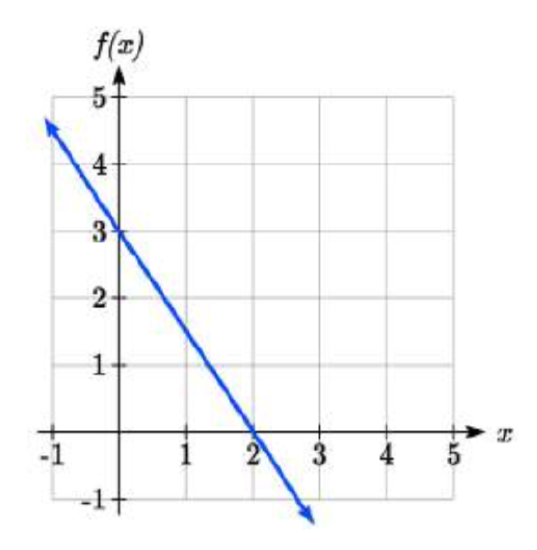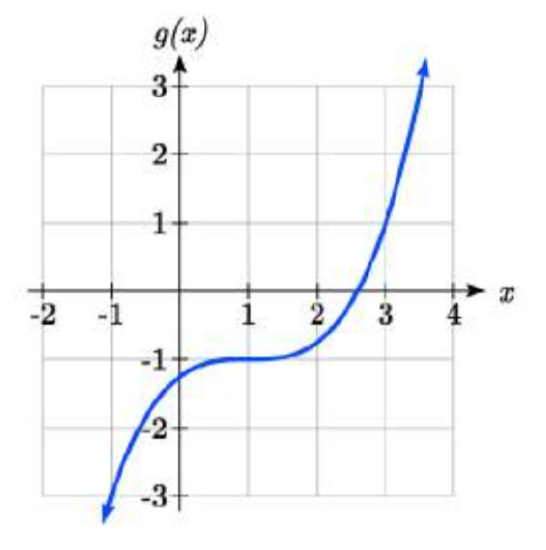1.6E: Inverse Functions
- Page ID
- 30243
section 1.6 exercises
Assume that the function f is a one-to-one function.
1. If \(f(6)=7\), find \(f^{-1} (7)\)
2. If \(f(3)=2\), find \(f^{-1} (2)\)
3. If \(f^{-1} (-4)=-8\), find \(f(-8)\)
4. If \(f^{-1} (-2)=-1\), find \(f(-1)\)
5. If \(f(5)=2\), find \((f(5))^{-1}\)
6. If \(f(1)=4\), find \((f(1))^{-1}\)
7. Using the graph of \(f(x)\) shown

a. Find \(f(0)\)
b. Solve \(f(x)=0\)
c. Find \(f^{-1} (0)\)
d. Solve \(f^{-1} (x)=0\)
8. Using the graph shown

a. Find \(g(1)\)
b. Solve \(g(x)=1\)
c. Find \(g^{-1} (1)\)
d. Solve \(g^{-1} (x)=1\)
9. Use the table below to find the indicated quantities.
| \(x\) | 0 | 1 | 2 | 3 | 4 | 5 | 6 | 7 | 8 | 9 |
| \(f(x)\) | 8 | 0 | 7 | 4 | 2 | 6 | 5 | 3 | 9 | 1 |
a. Find \(f(1)\)
b. Solve \(f(x)=3\)
c. Find \(f^{-1}(0)\)
d. Solve \(f^{-1}(x)=7\)
10. Use the table below to fill in the missing values.
| \(t\) | 0 | 1 | 2 | 3 | 4 | 5 | 6 | 7 | 8 |
| \(h(t)\) | 6 | 0 | 1 | 7 | 2 | 3 | 5 | 4 | 9 |
a. Find \(h(6)\)
b. Solve \(h(t)=0\)
c. Find \(h^{-1} (5)\)
d. Solve \(h^{-1} (t)=1\)
For each table below, create a table for \(f^{-1} (x).\)
11.
| \(x\) | 3 | 6 | 9 | 13 | 14 |
| \(f(x)\) | 1 | 4 | 7 | 12 | 16 |
For each function below, find \(f^{-1} (x)\)
13. \(f(x)=x+3\)
14. \(f(x)=x+5\)
15. \(f(x)= 2 - x\)
16. \(f(x)=3-x\)
17. \(f(x)=11x+7\)
18. \(f(x)=9+10x\)
For each function, find a domain on which \(f\) is one-to-one and non-decreasing, then find the inverse of \(f\) restricted to that domain.
19. \(f(x)=(x +7)^{2}\)
20. \(f(x)=(x-6)^{2}\)
21. \(f(x)=x^{2} -5\)
22. \(f(x)=x^{2} +1\)
23. If \(f(x)=x^{3} -5\) and \(g(x)=\sqrt[{3}]{x+5}\), find
a. \(f(g(x))\)
b. \(g(f(x))\)
c. What does this tell us about the relationship between \(f(x)\) and \(g(x)\)?
24. If \(f(x)=\dfrac{x}{2+x}\) and \(g(x)=\dfrac{2x}{1-x}\), find
a. \(f(g(x))\)
b. \(g(f(x))\)
c. What does this tell us about the relationship between \(f(x)\) and \(g(x)\)?
- Answer
-
1. 6
3. -4
5. 1/2
7a. 3
b. 2
c. 2
d. 211.
\(x\) 1 4 7 12 16 \(f^{-1}(x)\) 3 6 9 13 14 13. \(f^{-1}(x) = x -3\)
15. \(f^{-1}(x) = -x + 2\)
17. \(f^{-1}(x) = \dfrac{x - 7}{11}\)
19. Restricted domain \(x \ge -7\), \(f^{-1}(x) = \sqrt{x} - 7\)
21. Restricted domain \(x \ge 0\), \(f^{-1}(x) = \sqrt{x + 5}\)
23a. \(f(g(x)) = (\sqrt[3]{x + 5})^3 - 5 = x\)
b. \(g(f(x)) = \sqrt[3]{x^3 - 5 + 5} = x\)
c. This means that they are inverse functions (of each other)

